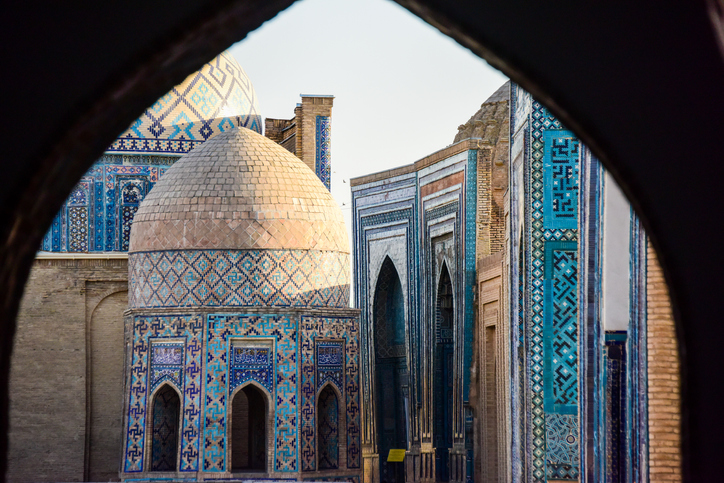
The famous Old Town in the City of Bukhara with the iconic Kalyan Minaret and Miri Arab Madressa, bathing in the sunset, in Khorezm Region, Uzbekistan, Central Asia. /Getty
The famous Old Town in the City of Bukhara with the iconic Kalyan Minaret and Miri Arab Madressa, bathing in the sunset, in Khorezm Region, Uzbekistan, Central Asia. /Getty
Editor's note: Djoomart Otorbaev is former prime minister of the Kyrgyz Republic, a distinguished professor of the Belt and Road School of Beijing Normal University, and a member of Nizami Ganjavi International Center. The article reflects the author's views, and not necessarily those of CGTN.
On October 16, Russia held its meeting with the foreign ministers of all five Central Asian countries in the "5+1" format. From now on, Moscow will develop not only bilateral ties but also formally regard Central Asia as a united region.
The "5+1" format, in which Central Asia states hold regular meetings with a single country outside the region, is not a new arrangement. Japan was the first country to institute such a cooperative format in 2004, followed by South Korea (2007), the European Union (2007), the United States (2015), and India (2019). On July 16 of this year, China held a similar meeting with the five Central Asian countries as well.
The promulgated statement of six ministers "on strategic directions of cooperation" can be considered as a program document that consolidates Russia's new approach to the region. This is a kind of new strategy for Russian foreign policy in Central Asia. As follows from the joint statement of the six ministers, from now on, meetings in such a circle will become regular.
Until Moscow recognized Central Asia as a single entity, most of the Western political analysts argued that Russia had specifically collaborated with each of the countries in the region separately. Hinting that Russia adheres to the old colonialist "divide and rule" principle.
I am categorically against speculations that anyone wants to see our region as a group of divided and unfriendly entities. This is a wrong and outdated myth. And I am sure that it is in the interest of all to see the region as predictable, safe, prosperous, secure, and friendly. But not to see it as a source of poverty and conflict.
The joint statement reflects the position of the participants in the meeting, but not of any external players. This distinguishes it from the U.S. or EU strategies. For example, they do not contain passages about the importance of promoting democracy, human rights, and other similar values. If in the American strategy the word "democracy" is mentioned five times, and "human rights" – four times, then in the joint Sino-Central Asian document these concepts do not appear at all. On the other hand, it outlines many other areas in which countries want to cooperate more actively.
The document guarantees mutual respect for the integrity and internal security of the various countries, with promises of mutual aid in case of need. The signatories specifically agreed not to make their territory, air, and sea space available for war need to other countries outside the region. As it is known the Americans are discussing the possibility of flying some routes over these areas with their military and observation aircraft, especially in Kazakhstan and Uzbekistan, for corridors to and from Afghanistan.

The Shah-i-Zinda mausoleums in Samarkand, Uzbekistan. /Getty
The Shah-i-Zinda mausoleums in Samarkand, Uzbekistan. /Getty
Russia is proposing closer collaboration in the fight against terrorism, drug trafficking and arms smuggling, and in the sphere of increasingly intense cyber wars, in this era of "hybrid" campaigns.
Great space is given to commercial cooperation programs and the development of transport in the region, currently severely compromised by the limitations related to pandemic. The statement outlined many other areas in which Russia would like to cooperate more actively with Central Asia, which demonstrates closer regional cooperation not only in words but also in deeds.
In recent years, there has been a significant increase in trade between the countries of the region: in 2018 it showed a 35 percent annual growth and amounted to $12.2 billion, and in 2019 it increased by more than 30 percent compared to the previous year.
Russia is the major investor in Central Asia. The accumulated assets, excluding capital investments from the jurisdictions of third countries, amount to about $20 billion, of which 47 percent was invested in the energy sector, 22 percent to the non-ferrous industry, and 15 percent to the telecommunications. More than 17,000 enterprises with Russian capital operate in the region. Russia provides technical assistance for the sustainable development of Central Asia. For the period from 2008 to 2019, its assistance amounted to more than $6 billion.
At the end of 2019, 172,000 citizens of the states of the region studied at Russian universities, of which 59,000 were funded from their federal budget.
In 2019, the number of migrant workers from Central Asia to Russia reached 6 million, which is four percent of the total population of Russia. According to the World Bank, the total amount of remittances of migrants from Russia to the countries of Central Asia has reached $9.4 billion. Some experts estimate that Central Asian migrants create up to 10 percent of Russia's GDP, which shows the mutually beneficial nature of such interaction. In Kyrgyzstan and Tajikistan, the remittances flows reached around 30 percent of their GDP, which is one of the highest in the world.
The absence of neither competition nor rivalry between China and Russia is particularly important for regional stability and security.
Now the main task for the countries in the region should be real cooperation in both economic and political spheres. A bit later additional opportunities will be opened for the transition to an even higher level of coordination and friendship.
(If you want to contribute and have specific expertise, please contact us at opinions@cgtn.com.)